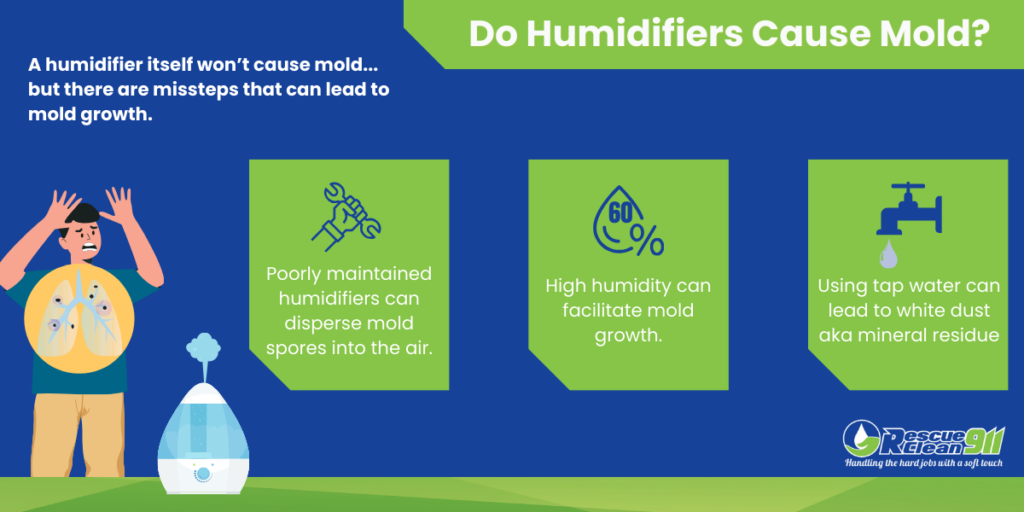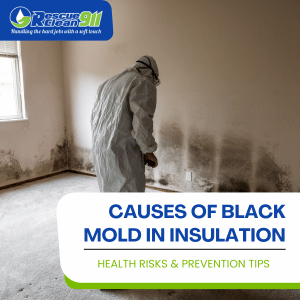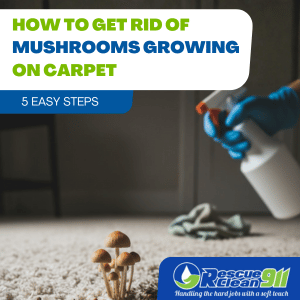Do Humidifiers Cause Mold?
While a humidifier itself does not cause mold, its misuse can create conditions that promote mold growth…If a whole-house humidifier alters the humidity level beyond the recommended, it can cause excess moisture…Portable humidifiers, if not properly maintained can lead to water droplets settling on surfaces around the humidifier and creating moist environments that promote mold growth.
Jump to:
How Would Humidifiers Promote Mold Growth?
If your humidifier is producing excessive moisture, it increases the ‘relative humidity’ level of your indoor environment. High humidity levels, above 60%, can create a favorable condition for mold to grow. To complicate things, different types of humidifiers can play unique roles in this scenario. A whole-house humidifier connects directly to your HVAC system to spread moisture throughout your home. If it alters the humidity level beyond the recommended range, whether due to a malfunction or incorrect settings, it can cause excess moisture – which is exactly what mold needs to thrive. Portable humidifiers, if not properly used or regularly cleaned, can lead to water droplets settling on surfaces around the humidifier and creating moist environments that promote mold growth. While a humidifier itself does not cause mold, its misuse can create conditions that promote mold growth. Following the manufacturer’s instructions about the use and maintenance can help ensure that your humidifier only contributes positively to your indoor air quality.Certain Conditions Can Accelerate Mold Growth
High humidity levels are a significant factor when it comes to mold growth. The relative humidity of your home should ideally be between 30% and 50% and if the upper threshold is crossed consistently, it can create excessive moisture. Since this excess moisture can quickly make surfaces around your home wet, mold spores then find a suitable breeding ground and begin multiplying, potentially causing an infestation.Water
The role of the water you use in your humidifier is important too. Using tap water, which often contains minerals and impurities, can result in ‘white dust’ – a residue that can be a breeding ground for mold spores. Using distilled or demineralized water can help prevent this.Type of Humidifier
We can’t emphasize enough the impact of specific types of humidifiers in creating conditions ideal for mold growth. For instance, cool mist humidifiers, ultrasonic humidifiers, evaporative humidifiers, and furnace humidifiers, each have a different mechanism of adding moisture to the air. Without a doubt, they serve their primary purpose effectively, but if the emission of cool mist or steam leads to excess moisture, it might foster mold growth.Maintenance
If these types of humidifiers are not cleaned regularly or the manufacturer’s instructions are neglected, stagnant water within them can be a perfect medium for mold to thrive. Once the mold establishes itself inside the humidifier, it won’t be long before the mold spores start getting dispersed with the mist into your environment, potentially causing health problems like allergies and respiratory infections.
Preventative Measures
Mold prevention is crucial not just for the longevity of your humidifier, but also for protecting your health and the ‘health’ of your home. Every humidifier needs regular and thorough maintenance. Each device often comes with its own set of instructions; make sure you adhere to them for both operating and cleaning. Controlling the relative humidity of your home is the first big step one can take. A hygrometer, an instrument for measuring humidity, can be very useful. Make sure you aim for a relative humidity level between 30% and 50%. During the winter months, the level can go a bit lower, around 25-40%, to prevent window condensation. Proper maintenance is a must in preventing mold growth. Cleaning your humidifier regularly– as specified by the manufacturer’s instructions– helps to ensure that no stagnant water is left to breed mold. Cleaning should not only involve emptying the tank and refilling it with fresh water but also disinfecting the unit’s surfaces, including the tank. Using distilled or demineralized water instead of tap water can hinder the chance of having mineral deposits in your humidifier which can be a potential breeding ground for mold. This is especially applicable to ultrasonic and impeller humidifiers, which can discharge mineral dust into the air. A well-maintained humidifier not only ensures a comfortable living environment but also secures the health of your family.Working Towards a Healthy Indoor Environment
Ensuring the right humidity level in a home can be a balancing act. Too little dampness can cause discomfort but if the air becomes too dry it can trigger issues like allergies and respiratory problems. But as we’ve learned, too much moisture from badly managed humidifiers and other sources can result in excess moisture leading to mold growth.By being well-informed and taking the right preventative measures, you can ensure that your house remains a home—safe, comfortable, and free of mold. At Rescue Clean 911, we are committed to creating healthy living spaces – it’s not just our profession but our passion. If you’re experiencing any trouble with mold, give us a call or contact us today for 24/7/365 service.








